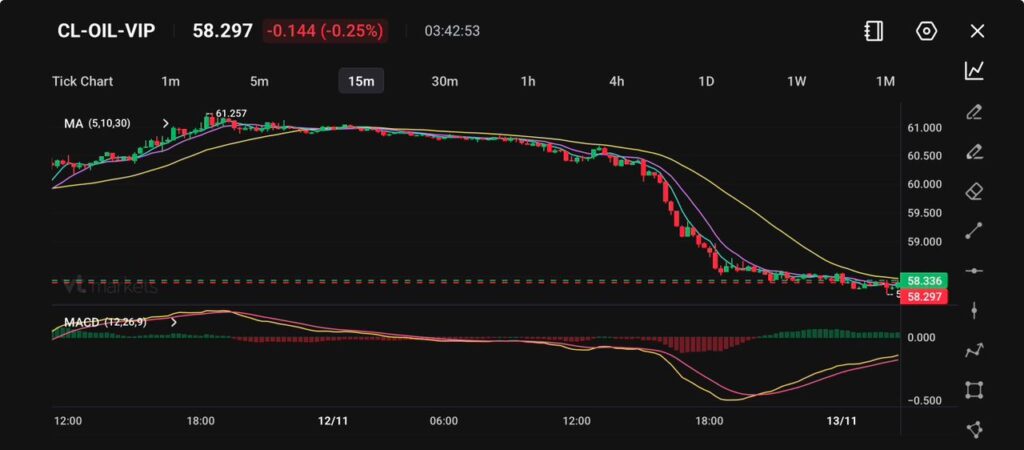
Key Points
- WTI crude dropped over 4% to $58.30, the lowest in three weeks, extending Wednesday’s decline.
- OPEC now expects global oil production to meet demand by 2026, citing a supply surplus in Q3.
Oil prices continued to weaken on Thursday, with WTI crude futures trading near $58.30 per barrel after sliding more than 4% in the previous session.
The fall followed OPEC’s latest assessment showing a well-supplied market through the mid-decade, a sharp reversal from its earlier deficit forecast.
The group noted that global supply exceeded demand in the third quarter and that production is likely to align with consumption by 2026, dampening expectations for a tighter market next year.
The tone was echoed by the U.S. Energy Information Administration (EIA), which raised its domestic production outlook for 2026, citing improved shale efficiency and higher rig utilisation.
The International Energy Agency (IEA) also tempered its long-term outlook, softening its stance on peak oil demand.
It now projects global consumption will continue rising until 2050, defying earlier expectations of a plateau in the 2030s.
Inventory Builds Deepen Pressure
Adding to the downside, data from the American Petroleum Institute (API) showed U.S. crude inventories rose by 1.3 million barrels in the week ending November 12.
If confirmed by official EIA figures, this would mark the second consecutive weekly build, reinforcing short-term oversupply concerns.
Traders now await the IEA’s monthly report later today for fresh cues on demand growth and inventory trends. Any further downgrades to consumption forecasts could push prices lower, especially amid strengthening U.S. output and subdued refinery demand.
Technical Analysis
Crude oil prices have slumped to $58.29, extending a steep intraday decline from highs near $61.26 as bearish momentum dominates.

The 15-minute chart shows prices trending sharply below the 5-, 10-, and 30-period moving averages, with the MACD widening deep in negative territory, signalling sustained downside pressure.
The structure reflects a decisive breakdown in short-term support zones, suggesting sellers remain firmly in control.
The move aligns with the broader weakness seen this week amid concerns over slowing global demand and renewed supply resilience from the U.S. and OPEC+ producers.
Cautious Forecast
With oil hovering just above key psychological support at $58, any further breach could open the path toward $57.50–$57.00, levels not seen since mid-October.
However, if prices can stabilise and reclaim $59.50, a corrective bounce toward $60.50 may develop. Traders should watch for potential volatility around U.S. CPI data and the upcoming OPEC+ commentary, which could determine whether this drop deepens or finds short-term footing.









